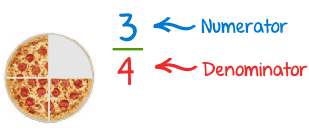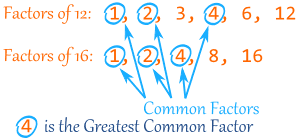Greatest Common Factor
The highest number that divides exactly into two or more numbers.
It is the "greatest" thing for simplifying fractions!
It is the "greatest" thing for simplifying fractions!
Let's start with an Example ...
So ... what is a "Factor" ?
Factors are the numbers we multiply together to get another number:

A number can have many factors:
(Read how to find All the Factors of a Number. In our case we don't need the negative ones.)
Why is this Useful?
One of the most useful things is when we want to simplify a fraction:
Finding the Greatest Common Factor
Example:
| Two Numbers | Factors | Common Factors | Greatest Common Factor | Example Simplified Fraction |
|---|---|---|---|---|
| 9 and 12 | 9: 1,3,9 12: 1,2,3,4,6,12 | 1,3 | 3 | 912 = 34 |
Other Names
The "Greatest Common Factor" is often abbreviated to "GCF", and is also known as:
- the "Greatest Common Divisor (GCD)", or
- the "Highest Common Factor (HCF)"
COMPARING FRACTIONS
Comparing Fractions
Sometimes we need to compare two fractions to discover which is larger or smaller. There are two easy ways to compare fractions: using decimals, or using the same denominator.
The Decimal Method of Comparing Fractions
Just convert each fraction to decimals, and then compare the decimals.
The Same Denominator Method

The denominator is the bottom number in a fraction.
It shows how many equal parts the item is divided into
When two fractions have the same denominator they are easy to compare:
But when the denominators are not the same we need to make them the same (using Equivalent Fractions).
Making the Denominators the Same
There are two main methods to make the denominator the same:
They both work, use which one you prefer!
Least Common Multiple(LCM)
The smallest positive number that is a multiple of two or more numbers.
Let's start with an Example ...
What Did We Do?
The trick was to list the multiples of each denominator, then find the Least Common Multiple
In the previous example the Least Common Multiple of 3 and 6 was 6.
In other words the Least Common Denominator of 13 and 16 is 6.
Here are the steps to follow:
 |
|



No comments:
Post a Comment